 Help Wanted:
Help Wanted:
1. Mistake correction
2. Drawing illustrations in vector
Mistake in the text? Select it and click CTRL + ENTER
 Help Wanted:
Help Wanted:
1. Mistake correction
2. Drawing illustrations in vector
Did you know that blown fuses are caused by horny electrons?
You might now be asking the questions, “Companies build equipment to meet electrical safety codes, don’t they? Wouldn’t this be adequate to guarantee the safety of players doing electrical play? Do these electrical safety measures protect players?”
This answer to this, dear readers – like other times in this book – is yes and no.
Here again we deal with the limits of models. It’s important, therefore, to look at electrical safety measures and see how they protect and not protect people doing electrical play.
What do manufacturers of electrical equipment do to provide electrical safety for their equipment? This can be the subject of several books alone, but here I’ll just cover a few of the most common ones and the ones that we’d see in electrical play and toys.
Take a look at one of your home appliances. You’ll notice that if it’s designed correctly, not damaged, and if you haven’t broken it open, it is designed so that you can’t get your fingers or any part of your or anyone else’s body in direct contact with the “live” electrical circuits – where you can touch a part that’s at household voltage (if you five in the U.S.) of 120 volts. Usually this is done by putting electrical parts inside boxes or the appliance, with insulation, with circuit protection (fuses and circuit breakers), and with grounding.
Electrical pans have been placed inside boxes for as long as appliances have been designed. Almost always such boxes are fireproof. Appliances are designed this way because when something goes wrong, electrical parts overheat – hot enough to start a fire. When these boxes are metal, special care is taken that the electrical parts inside are insulated and not in direct contact with the box. Finally, when the box’s cover is closed, you can’t touch anything inside.
The other contributor to electrical safety is insulation, You’re already familiar with insulators. There’s the rubber or plastic covering on wires, the plastic case on a television, etc. Such materials as plastics, wood, pressboard, wax, paper, oil, air and other gases, are used. Designers consider how the materials react to the heat generated in an accident when selecting an insulator.
As you remember about what was said about insulation in Chapter 2, insulators have high resistance – generally above 1,000,000 ohms. But if you remember too, not all is skittles and beer. Under voltages that are higher than the insulator can stand, the material will break down just like air. Thus the resistance becomes lower, and the insulator no longer acts as an insulator. Also, insulators can breakdown due to exposure to weather, sunlight, heat, or mechanical wear and abuse.
With these ideas of containment and insulation, let s look at some everyday examples.
Let’s take the television, for example. Your television is inside a plastic, metal, or wooden box. Even though there are ventilating holes or dots in this box so that the electronics can be cooled, these air vents are such that you can t readily stick your fingers inside. It is possible to poke a screwdriver or a hairpin into these vents, but almost all of us over the age of five know not to.
 Insulation is high-resistance material that keeps lower-resistance material – like you – from coming in contact with live wires.
Insulation is high-resistance material that keeps lower-resistance material – like you – from coming in contact with live wires.Inside the television there are voltages ranging from 5 to 25,000 volts or more. If you take a peek inside, you can see there are various types of insulation on the wires. The ones going to the picture tube that are at 25,000 volts (or more) have thick insulation. Because of the high voltages, the picture tube circuits are often the first to break down. When they do, they make the characteristic “burning insulation” smell that we are all familiar with.
House wiring is another example. Here, insulated wires are behind the wall. They’re either in metal pipes, called conduits, or in insulating jackets, Boxes are provided for outlets, switches and ceiling lights, Generally, wires inside the wall, if designed and installed correctly, do not overheat – but if you have seen old house wiring, you know that the insulation can get brittle and flake off easily if you handle it a lot.
Problems with house wiring usually start in the cords that connect with lamps and appliances. Extension cords also have the same problems. Because they are exposed, they are subject to water damage and mechanical abuse. Also, many people use too light an extension cord for heavy-current appliances. You sometimes see old lamps whose cords are frayed. I have also seen people running extension cords under heavily trafficked rugs and running them across wet lawns or even inside sink cabinets that can get wet. This would not be my choice of the ideal way to die, and I don t think it would be yours either… You don’t use frayed or damaged cords, do you?… No, no, just asking.
One feature of house wiring, as well as many appliances, is circuit protection. These are usually either fuses or circuit breakers.
Fuses “blow” and circuit breakers “trip” when they detect too much current flowing through a circuit that they’re protecting – the fuse or circuit breaker “opens up,” thus preventing any current from flowing in the circuit. They are designed so that they will operate properly for the maximum possible current flow and voltage that can be expected if there is a failure or “short” (actually a path of least resistance like you saw in Case 4 in Chapter 5) anywhere in the circuit, downstream of the fuse or circuit breaker. They are generally designed to act fast. “Fast” is considered to be one cycle of AC (Alternating Current) current – that’s about 16 milliseconds or 16/1, 000th of a second. In this way even though your toaster has a “dead short” in it (0 ohms across a 120 volt line), the fuse will blow or the circuit breaker will trip without causing a fire in the house wiring, having the toaster explode, having the fuse or breaker explode, or exposing you to a large enough voltage long enough to be a safety hazard to you.
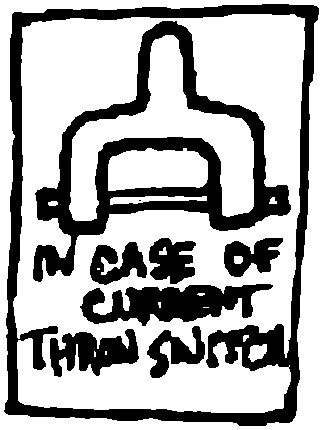 (In case of current, throw switch)
(In case of current, throw switch)You probably sort of already know about this, “So what?” you ask.
The reason I bring it up is that this is one of the things that people tend to cheat on.
In the old days people would sometimes put pennies behind fuses because they didn’t want to bother with them. They then wondered why they had electrical fires that burned the house down.
Fuses and circuit breakers are there for your safety. Even though modern fuses and breakers are hard to override or defeat, people still sometimes try, I remember one electrician I worked with who wanted to put a 2-amp fuse in an electronic circuit that was protected by a 1/2 amp fuse. Why? Because he had the 2-amp ones. They were the same size, and he didn’t want to walk all the way back to the supply room. Fortunately I saved the company the cost of some damaged equipment – and perhaps the cost of hiring and training a replacement electrician.
If a fuse blows or a breaker trips, find out why it did. Then repair the cause before replacing the fuse or resetting the circuit breaker. Finally, in replacing any fuses, use an exact replacement.
The final safety topic I’ll talk about is grounding. Grounding is really a simple concept to understand, but it can be confusing to consider the many ways it’s done electrically. Even electrical engineers only know about the particular grounding practices in their own fields; I wouldn’t want an engineer who solves grounding problems for computers to design a grounding system for a power plant. Each field has its own practices and ways of doing things – even though they are all doing “grounding.”
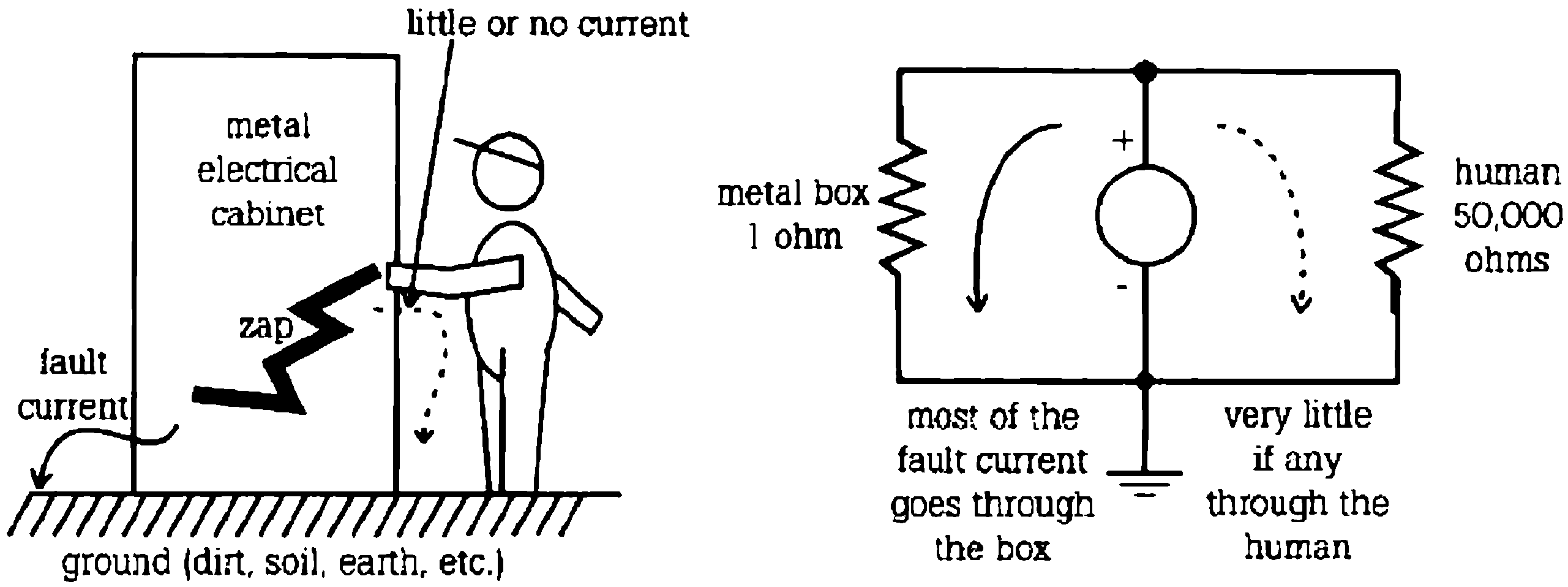
Figure 14: Grounding safety
Grounding essentially means that one side of a circuit runs through the earth. Earth – you know, ground, dirt, salt of, etc. Power companies do this with almost all their power lines, generators, and transformers. The idea is that if for some reason you have a short (one of the wires touches the metal box that ifs in), then the fault current goes directly to the earth for as long as it takes to blow the fuse or trip the circuit breaker. Anyone touching the box during this time will not be shocked because, even though they may be standing in a puddle of water at the time, the resistance from the box to the ground is much much lower than it is through the person (see fig. 14).
One important offshoot of this idea – not only for electrical engineers, power companies, but you too – is that the walls, ceilings, floors, pipes, electric conduit, and other things in a house or building are also considered ground.
“How car that be?” you ask. “I can see where pipes and electrical conduit can be grounds, but walls, ceilings, and floors are made of wood, and plasterboard, and other kinds of insulators. What’s going on, Unc?”
 Grounding means that one side of the circuit goes through the ground. Since the wire running into the ground has lower resistance than you do, shocks go through it, not you.
Grounding means that one side of the circuit goes through the ground. Since the wire running into the ground has lower resistance than you do, shocks go through it, not you.Well, it’s precisely because pipes and electrical conduit are buried in the walls, etc. of a building, that engineers get extra safe and say that all of this stuff is “ground” or “at ground.” Besides, if a wall or floor gets wet (like in an old bathroom, say), then they do act more like conductors than insulators.
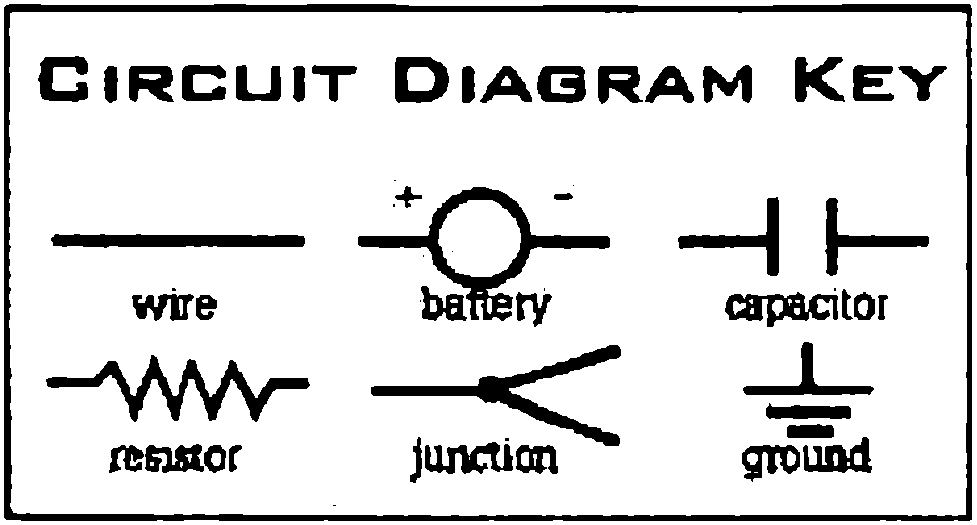
Grounding is also used to prevent static electricity from building up, i.e., to prevent too many excess charges accumulating (ahhh – static electricity again). This too is a safety matter For instance, on gasoline and oil tank trucks, a chain or strap dangles from the truck to the road so that any static electricity that accumulates on the tank is conducted by the chain to the road. Also at tank truck and railcar loading terminals, special grounding wires are attached to the tank to conduct away this static charge before loading or unloading the tank.
Lightning rods are another example of static electricity protection. The static charge that builds up on the ground due to the winds is conducted by the lightning rod wire to the lightning rod itself. That means that if a lightning bolt does strike, it will strike the lightning rod rather than try to go through the house or barn to get to the ground charge (see fig. 15).

Figure 15: Lightning rod
In household wiring the power company already grounds one side of the power line coming into the house. This side is called the neutral side and the other side is called the hot side. Even if you have a two-prong outlet, one side of it will measure 0 volts to ground. The other prong will measure 120 volts. The neutral prong is usually wider so that the cord won’t be plugged in the wrong way. Also light sockets are wired so that threads of the light socket are connected to neutral so that if you touch the threads when screwing in a light bulb, you won’t get a shock. In house wiring, the white wire is the neutral, and the black wire is hot.
In more modern house wiring, for additional safety, a third green (or bare copper) wire is only connected to ground. This wire provides extra protection from shock by providing a dedicated ground path for any fault currents.
In modern house wiring there are usually three-pronged outlets in the walls. The third, half-moon shaped prong is the ground wire. There are also three-pronged plugs that match the outlet. Some people cut this ground prong off their plugs because they want to plug the plug into a two prong outlet. I get mighty upset when I see this. The grounding prong is there for a safety reason. Don’t defeat it by cutting it off. In fact, you run the risk of destroying some electrically sensitive equipment like computers if you run them without a grounded circuit.
It’s also worth remembering that many household outlets are miswired – the hole for the third prong may not actually be grounded, or the “hot” and “neutral” wires may be switched. You can check this with an inexpensive gadget from the hardware store.
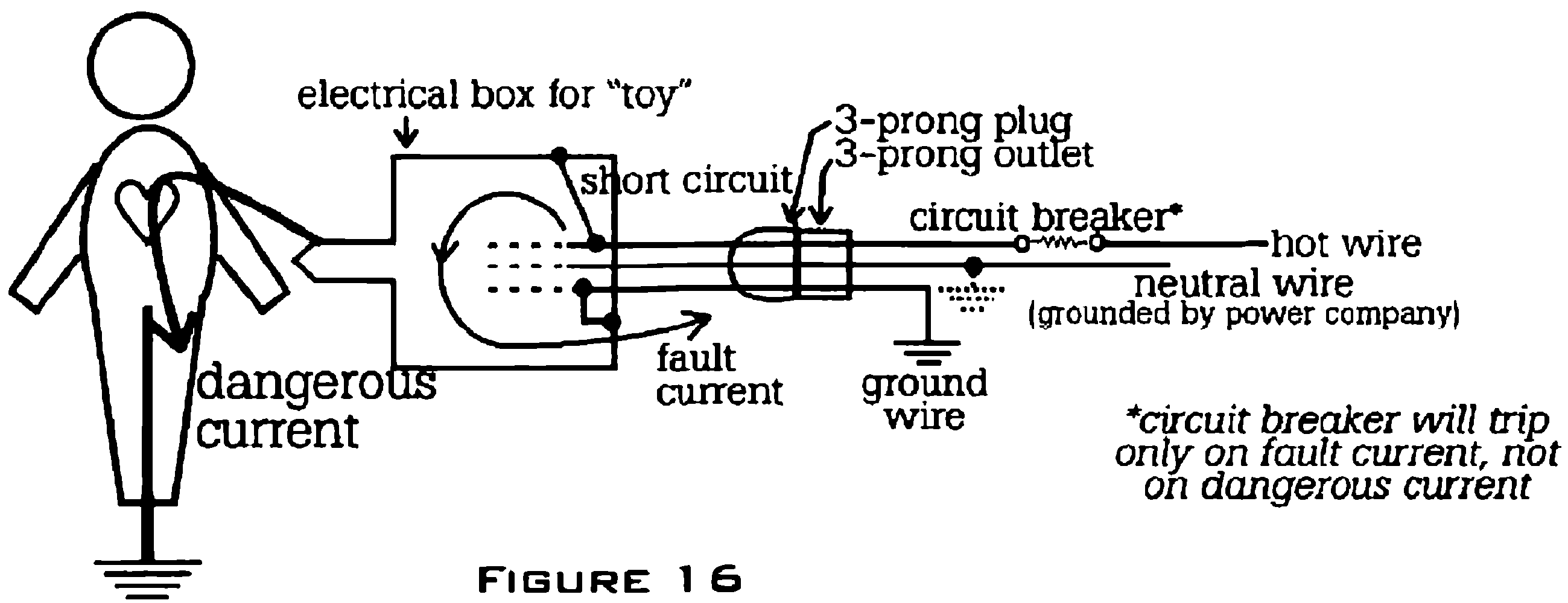
Figure 16
Also in modern house wiring they’re starting to require the use of Ground Fault Interrupters or GFI circuit breakers. This special circuit breaker measures the current flowing through the ground wire. The GFI circuit breaker is designed to trip at anything above 5 ma (milliamps) in the ground wire.
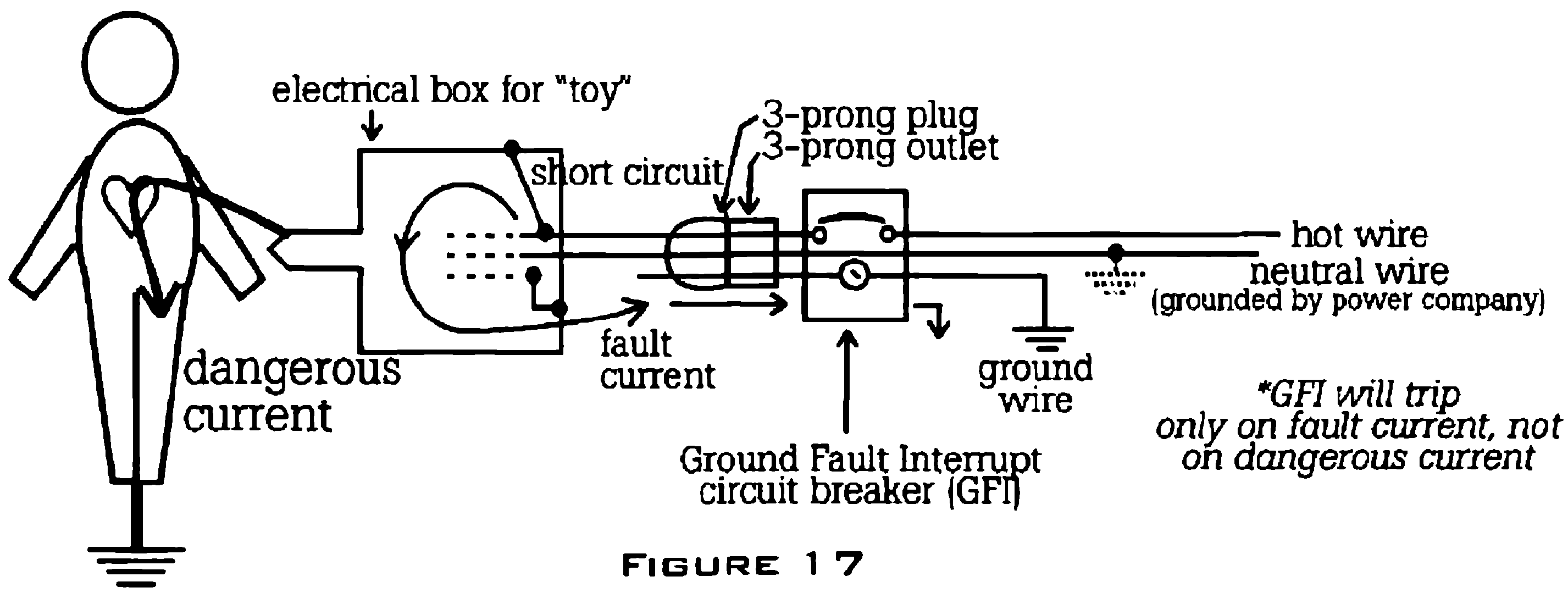
Figure 17
Sometimes the specific question is asked, “Will the use of 3-prong plugs or GFI circuit breakers make play toys safe?”
Well, yes and no. (Are you getting used to this yet?)
Take a look at figures 38 and 19 for the use of a 3-prong plug and a GFI circuit breaker respectively. In each case, the ground wire helps protect you from a short circuit of high voltage inside the protective box of the toy. It is, however, possible to still have dangerous currents coming from the toy and going to ground through the bottom. In other words, even these safer wiring strategies are not foolproof. Depending on where you receive the shock and how your body is grounded, a shock may still be harmful or fatal.
Oh! Sure you can go check your power cords and that light socket you rewired. I’ll wait.
Because electrical safety is a big issue, many cities and even the Federal Government have issued electrical building codes. The National Electrical Code (NEC) is the most commonly used. In these codes are specified all the rules and regulation about electrical wiring and equipment. But the NEC is not the only set of codes available. Electrical manufacturers also use the Underwriters’ Laboratory (UL) codes for making safe electrical equipment and appliances; you can see it in Chapter 12. There are hundreds of other codes.
The one thing that the NEC UL and other code books don’t cover is electrical play.
If you look at your electrical toys from the standpoint of electrical safety, you’ll see insulated or metal boxes, insulated wire, grounding plugs on household current powered devices, etc But is the equipment safe for use in play?
Electrical safety, as defined in the code books and as manufacturers build into their equipment, is only concerned with preventing electric shocks and fires when used with household wiring. This is important enough, but they’re not really concerned with their use as toys. Indeed, they may not even know about such uses. So when it comes to the safety issues that are of concern for us, we need to understand the limits of the existing electrical safety codes, understand the safety issues that are important to us, and understand that we need to be extra vigilant. In other words, we need to cover our own asses.
Understanding the play and the toys is the key to this safety. You need to learn from this book and other sources about the theory of the play and the toys you’ll use. You’ll also have to inspect your toys and make sure that they’re in good operating condition. This is especially true of the used toys you may find at an antique shop or a flea market. Frayed wires and damaged plugs can be dangerous and need to be replaced. Damaged circuits also need to be replaced properly. As a responsible, safe player, this burden is entirely on you. I also hope that the section on risk in Chapter 1 becomes clearer now in your understanding.